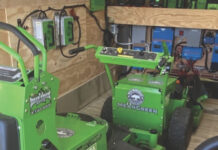By Brandon Haley
From the April 2023 Issue
The decision to switch a landscape maintenance fleet to electric has major financial implications. As a national education facility service company, we knew using electric equipment would help provide a better learning environment for students through noise reduction. We also wanted to reduce the carbon footprint of our fleet. Our environmental values and a goal to be at the forefront of Grounds Management drove our commitment to switch to electric equipment. Accounting for the lifetime costs of these purchases, however, required a plan that ensured our success with the switch.
It’s no secret electric equipment is much more expensive than its internal combustion engine (ICE) counterparts. This is primarily due to the cost of batteries, which is essentially comparable to pre-paying for fuel. Yet the higher up-front purchase price was only one factor. There were also facility infrastructure concerns to ensure charging capacity. Having site and route-based crews, we also had to figure out mobile charging.

We have learned many lessons since that first piece of electric equipment went into service. The largest one is that determining our exact return on investment (ROI) is complicated. Input costs vary from year to year and by location across the country. Our total cost of ownership for electric equipment is dependent on local costs of fuel and electric, not national averages. The ROI on handheld equipment is much clearer, but larger equipment such as electric zero turns have a breakeven point that may or may not be economically feasible based on their location.
What Are The Costs?
Understanding how fixed and variable operating costs work together can create a clear picture on the ROI that can be expected. ICE equipment has been the industry standard for decades, so the costs are well known. Determining all the costs for electric equipment, however, required some research at each site.
Fixed costs are obviously those that don’t change based on usage. For ICE equipment, this is simply the machine cost and any fuel storage. Electric equipment has many more fixed costs to consider including: the machine, batteries, chargers, infrastructure upgrades to the facility, and methods for mobile charging. Determining all these upfront costs accurately is a must for proper ROI analysis. Yet these costs can vary wildly depending on the amount of equipment and current electrical infrastructure.
Infrastructure Lessons. Consulting a licensed electrician to help determine the total amp load and serviceability of the electrical infrastructure in the charging location is always the first step. An important lesson we learned is the need to confirm that the service line for a building can carry the amp load needed for charging a fleet of equipment. A service line upgrade may take weeks or months to complete, impacting the entire landscape operation. It has also become common practice to confirm plug locations for handheld battery charging. Spreading chargers throughout the shop based on crew can ease morning trailer loading and eliminate traffic jams.

Batteries & SOPs. While some manufacturers have developed swappable batteries for zero turns, most mower units have a defined amount of power for the day. For hand-held equipment, we needed to determine the quantity of batteries to purchase. We found early on that we underestimated the number of batteries needed to keep a crew moving all day. With gas tools, there’s always more gas available instantly. With electric equipment, it can take upwards of 75 minutes to charge a battery. This meant the crew needed to prepare for their battery swap over an hour before needing it. We found new SOPs were needed to ensure a battery was always on the charger.
We use a simple chart based off the manufacturer’s expected run times to determine battery purchasing needs. We have found these numbers to be accurate, but we usually add a few minutes since it’s highly unlikely an operator will be going “full throttle” the whole time. The exception, of course, is blowing leaves.
The chart should include the time you expect the battery to be used, when it is expected to be charging, and how many minutes of reserve power are left waiting in the vehicle. (See FIGURE 1 above) Our goal is for crews to work without ever reaching zero reserve power. Overtime can and will happen. Always having a spare charged battery ensures our crews are ready for any change in plans. A good practice is to purchase one more battery than needed.

Mobility. To make charging efficient for mobile crews, it must be able to happen on-the-go. They need to take their power with them. While we anticipate that mobile solar charging systems will become more affordable and efficient in the future, the current answer is battery inverters. These units cost around $1.00 per watt and can power chargers in the field. These inverters come in multiple sizes and can be sized to the daily charging needs of a crew. (See Charging Landscape Trailers from the April 2023 issue.)
Variable Costs. The higher upfront costs of electric equipment are hard to process when everything is becoming more expensive by the day, but it’s important to not become discouraged. While more expensive upfront, electric equipment has much lower variable costs in maintenance and fuel. We have found it to be very reliable and require little maintenance. For most major manufacturers, the warranty period is very close to our desired life expectancy, bringing repair costs down even more.
Electricity is much cheaper than petroleum-based fuels, though its cost can be nearly doubled across the country. To properly forecast the electricity budget for a site, it’s important to look at local utility rate charts that detail kWh costs. These costs are then multiplied by expected demand to give an electricity budget that can be compared to a fuel budget for ICE equipment.
Our Breakevens
We have found that electric handheld equipment costs around $0.99 per hour less than ICE equipment. This gives us a breakeven point of less than two years for handheld electric equipment. If we are using blowers for leaf season, more batteries will be required, but the breakeven point is still less than three years. This number will continue to drop as batteries get better and store more power. Overall, we find that our purchase price of ICE handheld equipment is roughly 20% of the total cost of ownership, and the upfront cost of electric is 80%.
Electric zero turns and stand-ons are much more expensive upfront, and we find their total cost of ownership is very similar to ICE equipment. While operating costs are $6.31 lower than their ICE counterparts, this is offset by the significantly more expensive upfront cost. There are large tax credits available for electric zero turns which could completely change your analysis. Without these tax credits, we have found our breakeven point to be close to 2,500 hours. Each site is different, but this breakeven point is very close to our expected mower life.

Other Benefits
Battery powered OPE is changing our work environment and there are many intangible benefits, such as allowing longer work days due to noise ordinances. There’s also the ability to market sustainability initiatives. The benefits of using electric equipment are just beginning to be fully understood.
Determining the ROI on an electric equipment purchase is important to the financial well-being of any enterprise. It’s critical to use the most accurate input costs possible to determine where it makes sense to use electric equipment across a fleet. Knowing all our costs to purchase, outfit, and operate both electric and ICE equipment gives us the ability to make sound financial decisions.
 Haley, CGM is a Senior Project Manager, Grounds and Sustainability for SSC – Services for Education, a University and K-12 facilities services provider. He is also a Certified Grounds Manager through the Professional Grounds Management Society with 24 years of experience in the Green Industry.
Haley, CGM is a Senior Project Manager, Grounds and Sustainability for SSC – Services for Education, a University and K-12 facilities services provider. He is also a Certified Grounds Manager through the Professional Grounds Management Society with 24 years of experience in the Green Industry.
Do you have a comment? Share your thoughts in the Comments section below, or send an e-mail to the Editor at cmenapace@groupc.com.











![[VIDEO] Dickies®: Discover Workwear That’s Anything But Uniform](https://turfmagazine.com/wp-content/uploads/2023/06/1647663814-4b1a2a7742790a9b1e97a3b963477850192e1d6a9dfba9b07214a77bae25d6e3-d-218x150.jpg)






























![[VIDEO] Dickies®: Discover Workwear That’s Anything But Uniform](https://turfmagazine.com/wp-content/uploads/2023/06/1647663814-4b1a2a7742790a9b1e97a3b963477850192e1d6a9dfba9b07214a77bae25d6e3-d-324x160.jpg)